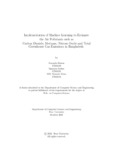| dc.contributor.advisor | Md. Saiful Islam | |
| dc.contributor.advisor | Islam, Md. Saiful | |
| dc.contributor.advisor | Rahman, Rafeed | |
| dc.contributor.author | Biswas, Sunanda | |
| dc.contributor.author | Sarkar, Spandan | |
| dc.contributor.author | Islam, MD. Manazir | |
| dc.date.accessioned | 2022-02-28T05:50:04Z | |
| dc.date.available | 2022-02-28T05:50:04Z | |
| dc.date.copyright | 2021 | |
| dc.date.issued | 2021-10 | |
| dc.identifier.other | ID 17101449 | |
| dc.identifier.other | ID 17101381 | |
| dc.identifier.other | ID 17101524 | |
| dc.identifier.uri | http://hdl.handle.net/10361/16364 | |
| dc.description | This thesis is submitted in partial fulfillment of the requirements for the degree of Bachelor of Science in Computer Science and Engineering, 2021. | en_US |
| dc.description | Cataloged from PDF version of thesis. | |
| dc.description | Includes bibliographical references (pages 44-47). | |
| dc.description.abstract | Nature and technology are two di erent subject matter with having much dissension
between each. Only a few years back, technological growth looked like a threat to
nature. However, the bene t of having huge computational power and Machine
Learning applications, computers now have the capability of visualizing the vital
component of nature. By using the concept of machine learning, researchers have
exhibited the limitless use of arti cial intelligence. As a part of that process, we have
identi ed a speci c problem on air pollution to tackle by using machine learning
that just the human brain is unable to determine. We have taken Bangladesh's
harmful emission factors into account, then trained them by using several machine
learning techniques like regression and deep learning to predict the emission level. In
consequence, we have applied models such as Linear Regression, Long Short Term
Memory and Multi- layer Perceptron and found highest 99.05% of accuracy rate
also described how this research can be extended in the context of other countries
in future years. | en_US |
| dc.description.statementofresponsibility | Sunanda Biswas | |
| dc.description.statementofresponsibility | Spandan Sarkar | |
| dc.description.statementofresponsibility | MD. Manazir Islam | |
| dc.format.extent | 47 pages | |
| dc.language.iso | en | en_US |
| dc.publisher | Brac University | en_US |
| dc.rights | Brac University theses are protected by copyright. They may be viewed from this source for any purpose, but reproduction or distribution in any format is prohibited without written permission. | |
| dc.subject | Deep learning | en_US |
| dc.subject | Linear regression | en_US |
| dc.subject | Long short term memory | en_US |
| dc.subject | Multi-layer perceptron | en_US |
| dc.subject | Emission factors | en_US |
| dc.subject.lcsh | Machine learning | |
| dc.subject.lcsh | Cognitive learning theory (Deep learning) | |
| dc.title | Implementation of machine learning to estimate the air pollutants such as Carbon dioxide, methane, nitrous oxide and total greenhouse gas emissions in Bangladesh | en_US |
| dc.type | Thesis | en_US |
| dc.contributor.department | Department of Computer Science and Engineering, Brac University | |
| dc.description.degree | B. Computer Science | |

